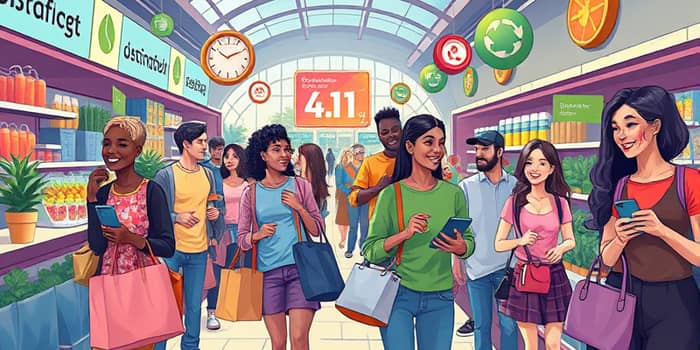In early 2025, the global marketplace stands at a crossroads of economic caution and transformative consumer values. As spending patterns evolve under inflationary pressure and technological innovation, businesses must adapt with agility and insight.
Although overall outlays have dipped year-over-year by 3.4% in the United States, a surprising one-third of consumers anticipate increased spending over the year, signaling latent confidence amid uncertainty.
Understanding the Current Landscape of Consumer Spending
Inflation and higher interest rates remain top concerns, with 76% of US consumers worried about escalating costs. Generations X and Boomers feel this strain most acutely, registering 87% and 88% levels of anxiety, respectively.
Amid this atmosphere, spending on essential goods has taken precedence over discretionary indulgences. Core CPI, excluding volatile food and energy, sits at 5.3%, driving a shift toward necessities and bargain-seeking behaviors.
Key Trends Shaping Consumer Choices in 2025
Sustainability has moved from niche to mainstream, as 58% of global consumers—and 60% of urban shoppers—express willingness to pay more for eco-friendly products. Younger cohorts, especially millennials and Gen Z, lead this charge, demanding greener solutions.
Online shopping remains significant but has cooled: 15% fewer consumers shop weekly online compared to last year. At the same time, social media shopping and AI-enabled recommendations are reshaping digital commerce, merging convenience with personalization.
- Prioritization of eco-friendly purchases driven by environmental awareness
- Focused spending on essentials over luxuries in response to sustained price pressures
- Evolution of e-commerce channels through social commerce, marketplaces, and AI
- Heightened demand for price and discounts superseding brand loyalty
Transforming Expectations: Loyalty, Experience, and Transparency
In today’s environment, even minor customer experience improvements can yield dramatic results: 68% of consumers increase repeat purchases when their experience improves. Conversely, 53% cut spending or abandon a brand after a single negative encounter.
Alongside service, consumers demand honesty. Nearly half (43%) of shoppers want brands to provide clear information on sourcing, production methods, and sustainability commitments, fostering trust in a crowded marketplace.
- Fast, free shipping and convenient returns
- Robust product reviews and social proof
- Seamless AI-driven customer experiences that anticipate needs
- Consistent value through discounts and loyalty programs
Macro Market Impact and Strategic Recommendations for Brands
Despite headline inflation easing from a peak of 4.9% to around 4%, elevated core inflation and periodic economic blackouts continue to suppress discretionary spending and slow growth in retail and service sectors.
For brands, the challenge is twofold: deliver affordability while upholding sustainability and digital innovation. Competitive pressure now spans global market entrants and agile digital natives setting new benchmarks for customer experience and value.
- Deliver excellent, reliable experiences to strengthen loyalty and referrals
- Maintain price competitiveness with targeted discounts and bundles
- Transparent, sustainable business practices to win younger audiences
- Leverage data analytics and AI to forecast demand and personalize offers
Seizing Opportunities in a Shifting Market
Brands that invest in robust digital platforms, enriched by AI and real-time data, will excel at delivering personalized, frictionless journeys. This not only enhances satisfaction but also deepens emotional connections, turning customers into advocates.
Moreover, by weaving sustainability into product design, supply chains, and storytelling, businesses can justify premium pricing and solidify long-term loyalty among eco-conscious segments.
A Roadmap for Future Growth
1. Map consumer segments by values and price sensitivity, then tailor offerings accordingly. 2. Pilot AI-driven personalization engines for dynamic pricing and recommendations. 3. Embed circular economy principles to reduce waste and improve brand reputation.
Each strategic move should be backed by continuous performance tracking and agile iteration, ensuring that companies can pivot as consumer sentiment and macro conditions evolve.
By embracing these insights and aligning operational priorities with consumer expectations, organizations can transform challenges into opportunities. The landscape of 2025 demands not only resilience but also visionary leadership—where purpose, technology, and value converge to drive sustainable growth.
In an era defined by economic uncertainty and digital disruption, the brands that succeed will be those that understand not only what consumers purchase, but why. By placing empathy, transparency, and innovation at the core of strategy, companies can navigate shifting currents and create lasting market impact.
References
- https://www.mckinsey.com/industries/consumer-packaged-goods/our-insights/the-state-of-the-us-consumer
- https://www.gwi.com/blog/consumer-spending-trends
- https://www2.deloitte.com/us/en/insights/industry/retail-distribution/consumer-behavior-trends-state-of-the-consumer-tracker.html
- https://www.junglescout.com/resources/reports/consumer-trends-2025/
- https://www.qualtrics.com/blog/global-consumer-trends/
- https://www.mikmak.com/blog/shifting-consumer-spending-patterns-and-the-rise-of-essential-items-a-market-overview
- https://www.coursera.org/articles/market-analysis
- https://www.earnestanalytics.com/insights/february-2025-us-consumer-spending-economic-blackout-and-slowing-activity










